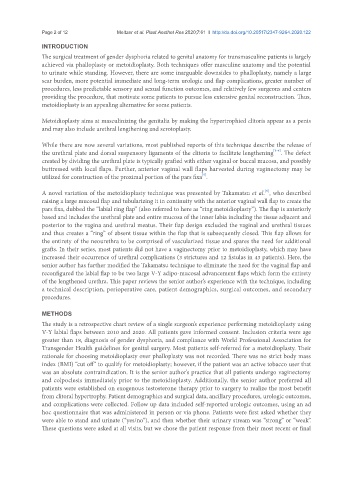Page 714 - Read Online
P. 714
Page 2 of 12 Meltzer et al. Plast Aesthet Res 2020;7:61 I http://dx.doi.org/10.20517/2347-9264.2020.122
INTRODUCTION
The surgical treatment of gender dysphoria related to genital anatomy for transmasculine patients is largely
achieved via phalloplasty or metoidioplasty. Both techniques offer masculine anatomy and the potential
to urinate while standing. However, there are some inarguable downsides to phalloplasty, namely a large
scar burden, more potential immediate and long-term urologic and flap complications, greater number of
procedures, less predictable sensory and sexual function outcomes, and relatively few surgeons and centers
providing the procedure, that motivate some patients to pursue less extensive genital reconstruction. Thus,
metoidioplasty is an appealing alternative for some patients.
Metoidioplasty aims at masculinizing the genitalia by making the hypertrophied clitoris appear as a penis
and may also include urethral lengthening and scrotoplasty.
While there are now several variations, most published reports of this technique describe the release of
[1-4]
the urethral plate and dorsal suspensory ligaments of the clitoris to facilitate lengthening . The defect
created by dividing the urethral plate is typically grafted with either vaginal or buccal mucosa, and possibly
buttressed with local flaps. Further, anterior vaginal wall flaps harvested during vaginectomy may be
[5]
utilized for construction of the proximal portion of the pars fixa .
[6]
A novel variation of the metoidioplasty technique was presented by Takamatsu et al. , who described
raising a large mucosal flap and tubularizing it in continuity with the anterior vaginal wall flap to create the
pars fixa, dubbed the “labial ring flap” (also referred to here as “ring metoidioplasty”). The flap is anteriorly
based and includes the urethral plate and entire mucosa of the inner labia including the tissue adjacent and
posterior to the vagina and urethral meatus. Their flap design excluded the vaginal and urethral tissues
and thus creates a “ring” of absent tissue within the flap that is subsequently closed. This flap allows for
the entirety of the neourethra to be comprised of vascularized tissue and spares the need for additional
grafts. In their series, most patients did not have a vaginectomy prior to metoidioplasty, which may have
increased their occurrence of urethral complications (3 strictures and 12 fistulas in 43 patients). Here, the
senior author has further modified the Takamatsu technique to eliminate the need for the vaginal flap and
reconfigured the labial flap to be two large V-Y adipo-mucosal advancement flaps which form the entirety
of the lengthened urethra. This paper reviews the senior author’s experience with the technique, including
a technical description, perioperative care, patient demographics, surgical outcomes, and secondary
procedures.
METHODS
The study is a retrospective chart review of a single surgeon’s experience performing metoidioplasty using
V-Y labial flaps between 2010 and 2020. All patients gave informed consent. Inclusion criteria were age
greater than 18, diagnosis of gender dysphoria, and compliance with World Professional Association for
Transgender Health guidelines for genital surgery. Most patients self-referred for a metoidioplasty. Their
rationale for choosing metoidioplasty over phalloplasty was not recorded. There was no strict body mass
index (BMI) “cut off” to qualify for metoidioplasty; however, if the patient was an active tobacco user that
was an absolute contraindication. It is the senior author’s practice that all patients undergo vaginectomy
and colpoclesis immediately prior to the metoidioplasty. Additionally, the senior author preferred all
patients were established on exogenous testosterone therapy prior to surgery to realize the most benefit
from clitoral hypertrophy. Patient demographics and surgical data, ancillary procedures, urologic outcomes,
and complications were collected. Follow up data included self-reported urologic outcomes, using an ad
hoc questionnaire that was administered in person or via phone. Patients were first asked whether they
were able to stand and urinate (“yes/no”), and then whether their urinary stream was “strong” or “weak”.
These questions were asked at all visits, but we chose the patient response from their most recent or final

